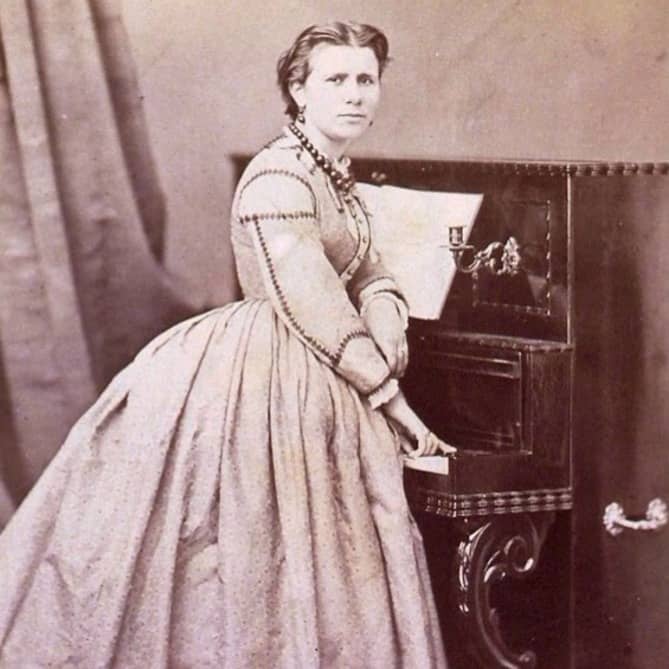
Expanding the Cello Repertoire to Include Women Composers
Wendy Velasco
Several years back I discovered a recording of a beautiful concerto written by the French pianist and composer, Marie Jäell. I immediately fell in love with it’s infectious melodies and knew I wanted to be able to play the piece. I discovered it was unpublished but the manuscripts were housed in the Bibliothèque Nationale et Universitaire de Strasbourg. A friend helped me obtain them so that I could prepare a score for cello and piano.
The Jäell concerto is the first known cello concerto written by a woman. Marie Jäell wrote the concerto in 1882 and dedicated the concerto to the cellist Jules Desart who performed the premier. One may assume that he helped her understand cello technique as the work is in a very comfortable key for cello (F Major) and lies well under the fingers. The simple harmonic structure gives the piece a charming, folk song like quality. Marie Jäell studied composition with Saint-Saëns who wrote his own A Minor cello concerto ten years prior in 1872. However, It is not known if she consulted Saint-Saëns on this concerto. The Dvořák cello concerto was written 14 years later in 1894. Both the Jäell and Dvořák concertos make similar use of horns in the orchestration and the folk like melodies.
The Allegro moderato movement begins with the main melody introduced by the orchestra cellos. The solo cellist enters soon after. The rise and fall of the passage reminds me of a sunrise at sea.

You can see the probable influence of her cello mentor in a descending arpeggio passage that almost sounds like something David Popper might have written. (Popper’s 40 Etudes were published in 1901).

The undulating arpeggios rise and fall like waves on an ocean culminating on a high F two octaves above middle C.
The concerto offers many opportunities for a budding cellist to hone their skills. There are soaring melodies…

Descending arpeggio patterns a la Saint-Saëns….

Double stop 6ths and 3rds….

Octave passages…

Even brooding melodies…

The Lento movement which I included in the piano and cello arrangement was never fully orchestrated by the composer and was therefore not included in the first recording of the piece. Jäell did include a complete piano part for the movement and a few pages of the beginnings of an orchestration. One can only speculate as to why the orchestration was not completed like the other movements. As mentioned before, the piece was written in 1882, the same year as her husband’s death. This movement is the most tragic of the concerto. There is a mournful funeral march rhythm in the piano accompaniment. Perhaps at its premier, the cellist didn’t want to perform such a tragic movement. Perhaps she didn’t finish because it was too personal. Or as another cellist mentioned, there are similar themes in the middle of the Lento and Andante movements. Perhaps she just preferred the version that was more joyful. Whatever the reason, I feel the movement has beautifully mournful melodies so it is included in my edition.

The Andante movement is the most accessible to play of the concerto. For sure, a cellist needs to be comfortable shifting and performing in all ranges of the cello. (The movement ends on a D above the treble clef staff). However, there are no double stops or awkward passages.
The melodies have a beautiful simplicity…

The Vivace molto movement opens with a joyful melody that leaps up the cello.

The movement offers plenty of opportunities to practice the thumb position!

A gorgeous brooding melody in the middle offers an opportunity for dialogue with the orchestral winds.

And the cadenza is written out with plenty of double stops to keep the fingers busy.

The piece has a thrilling ending that requires quick fingers and brings the cellist to the highest A on the cello before a dramatic finish on the low tonic F.
I hope cellists will explore this recently discovered work—the first known cello concerto written by a woman composer. After Jäell’s husband’s death, she studied musical composition regularly with Camille Saint-Saëns. She was close friends with Franz Liszt who, along with Saint-Saëns, performed her pieces for four hands. Marie Jaëll was one of the first women admitted into the Societe des Compositeurs de Music. Her manuscripts are housed in the Bibliothèque Nationale et Universitaire de Strasbourg.
The first published manuscript for cello and piano is available on Sheet Music Plus as a digital download to keep costs accessible for all.
A wonderful recording of the work performed by Xavier Phillips and the Brussels Philharmonic is available on i-Tunes and can be found on YouTube:

Sample of the Andante movement in the manuscript from the Bibliothèque Nationale et Universitaire de Strasbourg.
Subjects: Artistic Vision, Repertoire
